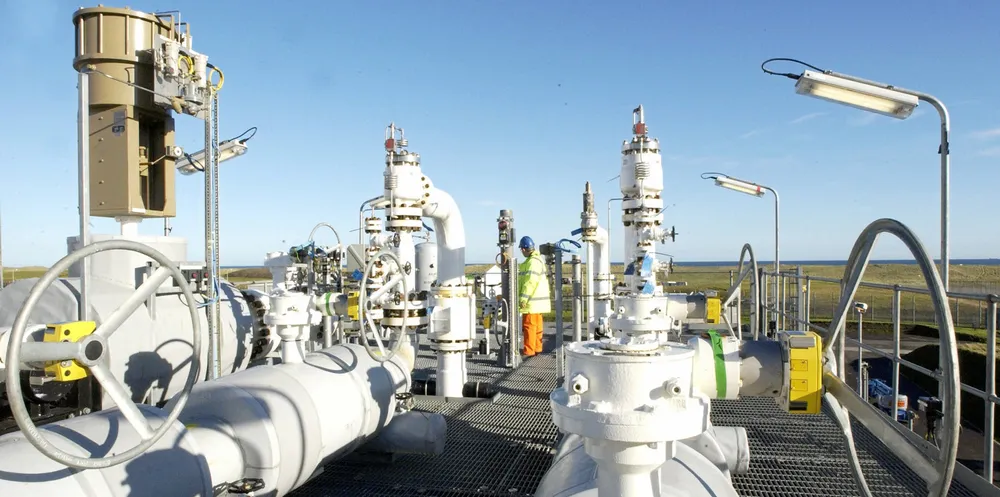UK gas infrastructure giant joins up for floating wind-and-hydrogen megaproject
Px Group, which manages industrial facilities including Scotland's St Fergus terminal, joins $14bn Cerulean Wind scheme to decarbonise North Sea oil & gas production

Construction of a £10bn ($14bn) floating wind megaproject that could halve current greenhouse gas emissions from UK’s offshore oil & gas operations by 2025 while generating industrial-scale volumes of green hydrogen has taken a key step forward with developer Cerulean Winds bringing onboard ‘delivery partner’ the Px Group, which operates industrial facilities including the giant St Fergus gas terminal in Scotland.
The deal would see Px Group shepherding development of three hydrogen production facilities – one in northeast England, another in northeast Scotland, and a third on the Shetland Islands – that would use “excess” power produced by a 200-unit offshore wind array which would be wired into to electrify major oil complexes in the central and northern North Sea.
“Px Group’s expertise and asset base make it a valuable addition to Cerulean’s UKCS [UK continental shelf] decarbonisation proposition,” said Dan Jackson, founding director of Cerulean Winds.
“This project which would see the offshore industry helping cut emissions from onshore industrial sites, is a real turning point in the shift towards a joined-up approach to tackling accelerating the decarbonisation of the UK’s on and offshore industrial facilities.
Under the agreement, Px Group would handle planning permissions and permitting for the hydrogen plant sites, which will be “aligned to best serve as [decarbonisation] hubs for the northern and central North Sea”, and later operating the facilities and associated onshore infrastructure, including substations and grid connections.
Key to the Cerulean megadevelopment is the use of the surplus power produced by the floating wind units to generate hydrogen as it would mean the project would not need a grid connection as such, something that “would only delay the project”, said Jackson.
“We don’t more green electrons coming on to the grid – we need to decarbonise production offshore and produce green molecules [clean hydrogen].”
Px Group CEO Geoff Holmes said: “We are delighted to be working with Cerulean on this potentially ground-breaking project. Operating and managing infrastructure which supports the UK’s energy transition is core to our business and we are thrilled to be able to support the decarbonisation of offshore facilities in the North Sea.”
Jackson said the Cerulean project, spread over two sites in the West of Shetland and in Central North Sea called ‘Aspen’ and ‘Beech’, could “far exceed” the goals for offshore CO2 reduction set out in the UK government’s North Sea Transition Deal, which calls for a 10% by 2025, rising to 25% in 2027 and 50% by 2030, while at the same time using the green hydrogen generated to decarbonise other industrial sectors.
“That lines us up to put us on a par with other countries such as Germany which has taken the decision to decarbonise its heavy industries and is actively looking at how to use green energy from windfarms to do that,” he said.
Cerulean last month named its first delivery partners for the project, marine contracting giant NOV, which will supply the floating platforms and mooring spreads.
Cerulean has submitted a formal request for seabed leases for the project to Marine Scotland but “timing involved in gaining approvals for the project is critical”, said Jackson, for the company to be able to reach financial close in Q1 2022 and have the project infrastructure built and then power ramping up between 2024-2026.
To this end, Cerulean has asked the Scottish and UK governments to make an “exceptional case to deliver an extraordinary outcome” in speeding the decarbonisation of one of the biggest offshore oil basins in the world.
“Everything hinges on those leases being granted, even conditionally, by this autumn so we can move ahead on schedule. The risk of not moving quickly on basin-wide decarbonisation would wholly undermine the objectives set out in the North Sea Transition Deal and delay the potential of making a significant impact on reducing emissions from onshore industrial assets.”